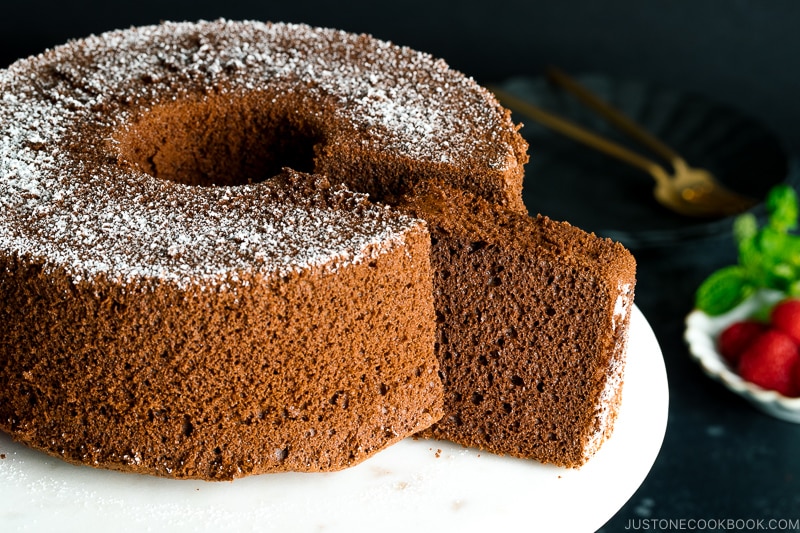Chocolate Chiffon Cake
4.1
(129)
Your folders
Your folders
Prep Time: 30 minutes
Cook Time: 40 minutes
Total: 70 minutes
Servings: 1
Author : Namiko Chen

Ingredients
Export 6 ingredients for grocery delivery
Instructions
Step 1
Gather all the ingredients and preheat the oven to 340ºF (170ºC). For a convection oven, reduce cooking temperature by 25ºF (15ºC). You will also need an 8” (20 cm) chiffon cake pan. If you have a different size pan, please read this post to adjust the ingredients.
Step 2
In a bowl, combine cake flour (80 g, ⅔ cup), baking powder (5 g, 1 ¼ tsp), and Dutch-processed cocoa powder (40 g, ½ cup) and mix well with a fork/whisk.
Step 3
Separate 5 large eggs to yolks and whites. Keep the egg whites in a stand mixer bowl and egg yolks in a large mixing bowl.
Step 4
Refrigerate (or freeze) the bowl with egg whites for 15 minutes so both bowls and egg whites are cold (it’s okay if the egg whites are partially frozen). In Japan, we chill the egg whites to make smooth, fine-textured meringue and do not use cream of tartar.
Step 5
Beat the egg yolks.
Step 6
Add granulated sugar (65 g, ⅓ cup). Whisk vigorously until it’s a creamy pale yellow color.
Step 7
Add the oil (60 ml, ¼ cup) and beat to combine with the whisk.
Step 8
Add the milk (90 ml, ⅓ cup +1 ½ Tbsp) and vanilla (5 ml, 1 tsp) and combine well.
Step 9
Using a fine-mesh sieve, sift half of the dry ingredients. Whisk well to combine.
Step 10
Add the rest of the dry ingredients and mix well until just combined and no lumps (do not overmix).
Step 11
Take out the bowl of egg whites and set your stand mixer with a whisk attachment.
Step 12
Start whipping the egg whites on medium speed (level until the egg whites are bubbly, opaque, and foamy.
Step 13
Gradually add granulated sugar (65 g, ⅓ cup) in small increments while whisking. Once you add all the sugar, change to a higher speed (level and beat vigorously until stiff peaks form.
Step 14
To check on stiff peaks, pull up your whisk and see if the egg whites go straight up and just the tip is soft enough that it folds over, like taking a bow. This is a stiff peak stage. By this time, the meringue should have a glossy texture. TIP: I usually pause beating when the egg whites are getting close to the stiff peak stage. Take out the whisk attachment from the mixer and hand-mix the egg whites till homogenous in texture. Typically, the egg whites near the edge of the bowl are looser (not close to stiff peaks) compared to the center of the bowl. Then put the whisk back and continue beating till stiff peaks.
Step 15
Using a whisk, take ¼ of the meringue from the bowl and add to the batter. Whisk well to combine until homogenous.
Step 16
Take a third (⅓) of the meringue left in the bowl and this time, gently fold in without deflating the air bubbles in the meringue and batter.
Step 17
Take another third and repeat the process.
Step 18
Take the final third and gently fold in. Make sure to thoroughly mix without deflating the air bubbles.
Step 19
The consistency should look like this when you lift the whisk. Switch to the spatula and fold in one last time, scraping from the side and bottom of the bowl, making sure there is no chocolate accumulation.
Step 20
From 6-8 inch high, pour the batter into the ungreased 20-cm (8-inch) chiffon cake pan at the same location to prevent more bubbles from forming. Gently tap the cake pan on the working surface to release the air pockets in the batter.
Step 21
Run a wooden skewer through the batter to release air pockets. Put the cake pan in the middle rack of the oven and bake at 340ºF (170ºC) for 35-40 minutes (40 minutes for my oven).
Step 22
When it’s done baking, insert the wooden skewer in the middle of the cake to see if it comes out clean (If wet, bake longer) and the top of the cake springs back when gently pressed. If the top gets burn too quickly (maybe heat source is too close), cover the top loosely with aluminum foil.
Step 23
Remove the cake pan from the oven and gently drop the pan onto the working surface to shock the cake so it stops shrinking.
Step 24
Prepare a bottle with a long neck and invert the cake pan to let cool completely in its cake pan so that it stretches downward.
Step 25
Once the cake is completely cool, run offset spatulas around both inner and outer edges of the cake (I use a large/long spatula for outside and bottom and a small spatula for around the inner tube). I used to use a knife, but the tip of the knife tends to poke the cake while moving around, so I stopped using it.
Step 26
Gently remove the cake from the pan and run the offset spatula on the bottom of the cake.
Step 27
Invert the cake onto a plate or cake stand. Chiffon cake is served “upside-down”, the flat bottom side being on top.
Step 28
Dust with powdered sugar and decorate with raspberries and mint leaves if you like. I strongly recommend consuming the cake soon, however, you can keep the cake at room temperature (cooler place) in a cake stand with a cover for 1-2 days. To keep longer, wrap individual slices in a plastic wrap or put in an airtight container and store in the refrigerator for 3 days or in the freezer for 2 weeks.